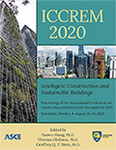International Conference on Construction and Real Estate Management 2020
Research on Chinese Brand Building of Major Projects under the Background of the Belt and Road
Publication: ICCREM 2020: Intelligent Construction and Sustainable Buildings
ABSTRACT
The construction of major infrastructure projects is a priority area of the Belt and Road initiative. In view of the specific cultural and political background of the countries along the B&R, Chinese brand of major projects should be built, which is conducive to enhancing Chinese international competitiveness in the field of engineering construction. Based on the project life cycle theory and stakeholder theory, this paper constructs the framework of Chinese brand elements of major projects and provides theoretical support for the construction of Chinese brands. The research conclusion not only provides a reference for establishing a good Chinese brand image, but also facilitates the construction of the Belt and Road.
Get full access to this article
View all available purchase options and get full access to this chapter.
ACKNOWLEDGMENTS
This work was funded by the Humanities and Social Sciences Projects of Ministry of Education (No. 18YJA630113), the Humanities and Social Sciences Projects of Guangdong General Universities (No. 2017WTSCX097), and “University Innovation and Strong” Projects of Education Bureau of Guangdong Province (No. 2016WQNCX120).
REFERENCES
Arditi, D. and Gunaydin, H.M. (1997). “Total quality management in the construction process.” International Journal of Project Management, 15(4), 235-243.
Chernatony, D. and Leslie H. (1993). “Categorizing brands: evolutionary processes underpinned by two key dimensions.” Journal of Marketing Management, 9(2), 173-188.
Doyle, P. (1989). “Building successful brands: the strategic options.” Journal of Product and Brand Management, 5(2), 77-95.
Eriksson, P.E. and Szentes, H. (2017). “Managing the tensions between exploration and exploitation in large construction projects.” Construction Innovation, 17(4), 65-72.
Flyvbjerg, H. and Bent, D. (2014). “What you should know about megaprojects and why: an overview.” Project Management Journal, 45(2), 6-19.
Huang, Y., Fischer, T.B. and Xu, H. (2016). “The stakeholder analysis for sea of Chinese foreign direct investment: the case of ‘one belt, one road’ initiative in Pakistan.” Impact Assessment and Project Appraisal, 34(3), 1-14.
Kibert, C.J., Sendzimir, J. and Guy, G.B. (2002). Construction ecology: nature as the basis for green buildings,Spon Press, Oxford.
Langford, D. and Male, S. (2008). Strategic management in construction, John Wiley and Sons, New York.
Levitt, B. and Raymond, E. (2007). “CEM research for the next 50 years: maximizing economic, environmental, and societal value of the built environmental.” Journal of Construction Engineering and Management, 133(9), 619-628.
Loosemore, M. and Phua, F. (2010). Responsible corporate strategy in construction and engineering: doing the right thing? Spon Press, Oxford.
Luo, L., He, Q., Xie, J., Yang, D. and Wu, G. (2016). “Investigating the relationship between project complexity and success in complex construction projects.” Journal of Management in Engineering, 33(4), 1-12.
Miller, R. and Hobbs, B. (2005). “Governance regimes for large complex projects.” Project Management Journal, 36(3), 42-50.
Morrison, C.J. and Schwartz, A.E. (1996). “State infrastructure and productive performance.” American Economic Review, 86(5), 1095-1111.
Olander, S. (2007). “Stakeholder impact analysis in construction project management.” Construction Management and Economics,25(3), 277-287.
Paek, J.H. and Ock, J.H. (1996). “Innovative building construction technique: modified up/down method.” Journal of Construction Engineering and Management, 122(2), 85-93.
Rubin, J., Schultz, M. and Hatch, M.J. (2008). “Coming to America: can Nordic brand values engage American stakeholders?” Journal of Brand Management, 16(2), 30-39.
Sanderson, J.(2012). “Risk, uncertainty and governance in megaprojects: a critical discussion of alternative explanations.” International Journal of Project Management, 30(4), 432-443.
Scott, D.M. (2010). The new rules of marketing and PR: how to use social media, blogs, news releases, online video, and viral marketing to reach buyers directly, John Wiley and Sons, New York.
Stone, R. (2008). “Three gorges dam: into the unknown.” Science, 321(1), 25-32.
The International Organization for Standardization (ISO). (2006). ISO 26000: Guidance on Social Responsibility, Geneva, Switzerland.
Wu, J.G., Huang, J.H., Han, X.G., Xie, Z.Q. and Gao, X.M. (2003). “Three gorges dam: experiment in habitat fragmentation.” Science, 300(1), 1239-1240.
Zeng, S.X., Ma, H.Y., Lin, H., Zeng, R.C. and Tam, V.W.Y. (2014). “Social responsibility of major infrastructure projects in China.” International Journal of Project Management, 33(3), 537-548.
Information & Authors
Information
Published In
ICCREM 2020: Intelligent Construction and Sustainable Buildings
Pages: 216 - 223
Editors: Yaowu Wang, Ph.D., Harbin Institute of Technology, Thomas Olofsson, Ph.D., Luleå University of Technology, and Geoffrey Q. P. Shen, Ph.D., Hong Kong Polytechnic University
ISBN (Online): 978-0-7844-8323-7
Copyright
© 2020 American Society of Civil Engineers.
History
Published online: Oct 14, 2020
Published in print: Oct 14, 2020
Authors
Metrics & Citations
Metrics
Citations
Download citation
If you have the appropriate software installed, you can download article citation data to the citation manager of your choice. Simply select your manager software from the list below and click Download.
